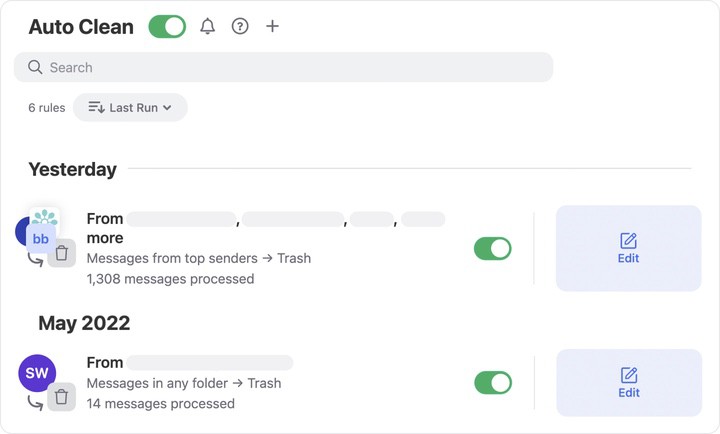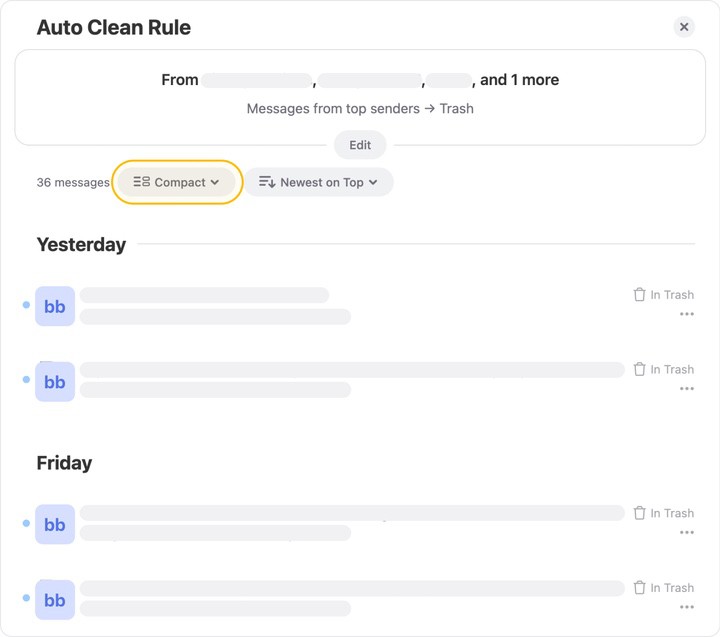Managing Auto Clean Rules
Auto Clean is one of the most powerful features of Clean Email because it lets you set up custom future actions that Clean Email will apply to specific types of email messages. Using Auto Clean, you can create rules to automatically apply almost any action to messages that meet almost any specific criteria.
This article shows you how to manage your Auto Clean rules, including the following topics:
- Searching and Sorting Auto Clean Rules
- Reviewing Auto Clean Actions
- Pausing Auto Clean Rules
- Deleting Auto Clean Rules
For more information about the Auto Clean feature, please see these related articles:
Searching and Sorting Auto Clean Rules
To help you find the Auto Clean rule you want to review, edit, pause, or delete, you can use the search field at the top of the Auto Clean page. You can search on almost any field that has previously been configured as part of the rule, including:
- The sender’s name or email address
- The name of the cleaning action
- Any search string used to identify messages to be cleaned
- The label, if a label is used to identify messages
- …and more
Simply type the first few characters you want to search for, and the list of rules is dynamically updated as you type.

The sort button that appears just below the search field lets you control the sequence in which the rules appear. The default value is Last Run, which means the rules are listed in descending sequence with the rules that have been run most recently at the top of the list.

You can click the drop-down if you want to choose a different sort sequence, including sorting by the number of cleaned messages or the by action associated with each rule.

Reviewing Auto Clean Actions
Once you have activated one or more Auto Clean rules, Clean Email will continually apply the actions in those rules automatically (without any further actions from you), until you change, disable, or delete the rules.
Since Auto Clean actions happen without any user intervention, it may be easy to forget about the rules you have created and the actions Clean Email is continuing to take on your behalf. To help you stay informed, there are two ways you can review actions that Auto Clean has taken.
Previewing Messages Affected by Auto Clean Rules
To preview messages that have been affected by Auto Clean rules, access the Auto Clean feature. A list of Auto Clean rules appears.

Click the individual rule for which you want to see processed messages. The list of processed messages appears in the preview pane to the right.

In the context of Auto Clean rules, the term “processed” may have multiple meanings, depending on what actions you have selected for your rules. For example, processed messages may be deleted, moved to the trash, moved to a different folder, or marked as read.
In the example above, the rule is designed to trash all messages that meet the rule criteria, so all of the messages that have been processed by the rule are currently in the trash.
You can control the sort order of the processed messages list by clicking the sort button to the right of the total number of messages.

The available sort options are:
- Newest on Top (this is the default sort) - This sorts messages by age, in descending order with the newest messages at the top of the list.
- Oldest on Top - This sorts messages by age, in ascending order with the oldest messages on top.
- Name (A-z) - This sorts messages in alphabetical order by the sender’s name.
- Email Address (A-z) - This sorts messages in alphabetical order by the sender’s email address.
To control how much information is displayed for each processed message, click the drop-down to the left of the sort sequence. The default view is Detailed, which includes descriptions from each message’s email header. If you instead choose Compact, many of the message details (including descriptions) are suppressed to save space on the screen.

If you need to make changes to the Auto Clean rule’s settings, click the Edit button at the top of the preview pane.

For more information about editing Auto Clean rule settings, please see Creating and Editing Auto Clean Rules.
Auto Clean Summary Notifications
In addition to displaying a list of processed messages on demand, Clean Email can email you summary notifications of Auto Clean actions on an hourly, daily, or weekly basis. These summary notifications are only sent when actions have been taken affecting one or more messages.
Enabling Auto Clean Notifications for Your Account
In order to receive Auto Clean notifications, you need to enable them for your account. To do this, click the notifications icon to the right of the Auto Clean page name.

Alternatively, you can access the Notifications page by clicking your account at the top of the left-hand navigation pane, and then click Notifications.

On the Notifications page, the Action History Summary section lets you control whether or not and how often these notifications are sent.

In the illustration above, the Action History Summary notifications are enabled; the toggle is turned on so the button is on the right-hand side and the toggle is green.
When the notifications are enabled, you can click the frequency drop-down and choose to have Clean Email send the notifications hourly, daily, or weekly.
If you want to disable these notifications, click the toggle to turn it off. The button moves to the left-hand side of the toggle, and the green background goes away.

Regardless of the selected frequency, Clean Email does not send the notifications in any period when no messages have been affected by Auto Clean rules.
Choosing Which Auto Clean Rules Are Included in Notifications
For each Auto Clean rule, you can control whether or not the associated cleaning actions are included in the Action History Summary notifications. If you want the rule’s actions to be included in the notifications, ensure that the toggle labeled Include this rule in Action History is enabled when creating or editing an Auto Clean rule. When the toggle is enabled, the button appears on the right-hand side of the toggle and the toggle turns green, as illustrated below.

When the toggle is disabled, the button appears on the left-hand side of the toggle and the green color goes away, as shown here:

Pausing Auto Clean Rules
In case you suspect that a specific Auto Clean rule may be having unexpected effects, or if you need to temporarily suspend a rule for any reason, click the toggle to the right of the rule you want to disable, in the list of Auto Clean rules.
When the rule is enabled, the button appears on the right-hand side of the toggle, and the toggle turns green.

If you click to disable the rule, the button moves to the left-hand side of the toggle, and the green color goes away.

When an Auto Clean rule is disabled, its action does not occur. The rule will not run or take any cleaning actions until it is toggled back on.
📌 Note: If you are not sure which rule might be causing the unexpected effects, you can also temporarily disable the Auto Clean feature entirely by clicking the toggle to the right of the Auto Clean title at the top of the page.

For more information on enabling and disabling Auto Clean, please see Auto Clean Overview.
Deleting Auto Clean Rules
If you need to permanently delete an Auto Clean rule, begin by clicking Edit to the right of the rule.
📌 Note: Deleting an Auto Clean rule does not affect messages that have already been cleaned by the rule. Deleting an Auto Clean rule is permanent; if you change your mind later you would need to manually recreate the rule’s settings.

Click Delete at the bottom of the rule’s settings dialog.

A confirmation dialog appears. Click Delete to confirm that you want to delete the rule.

Please contact us and we will be happy to help.